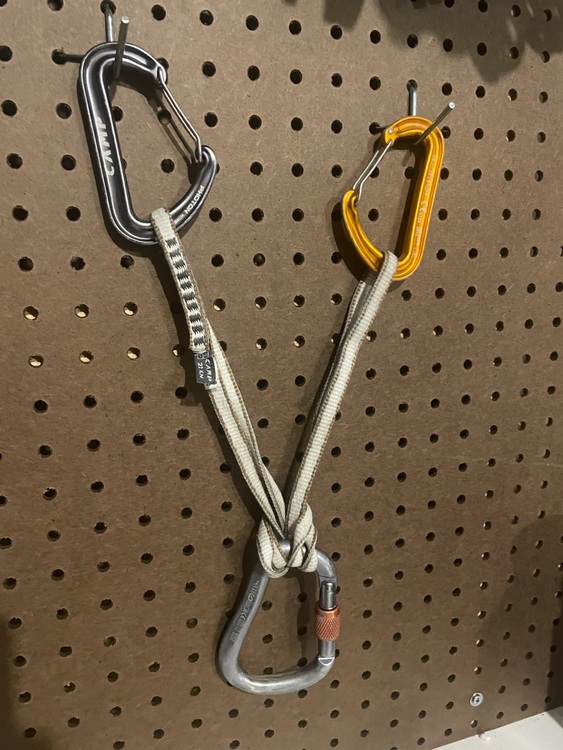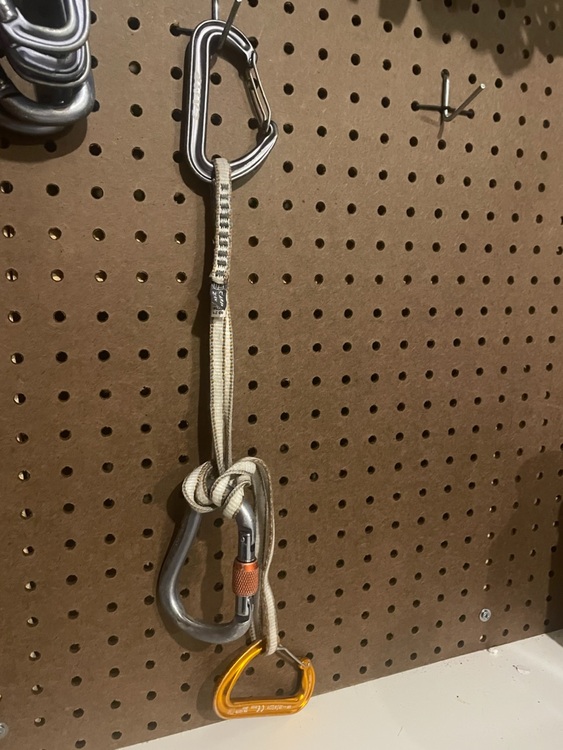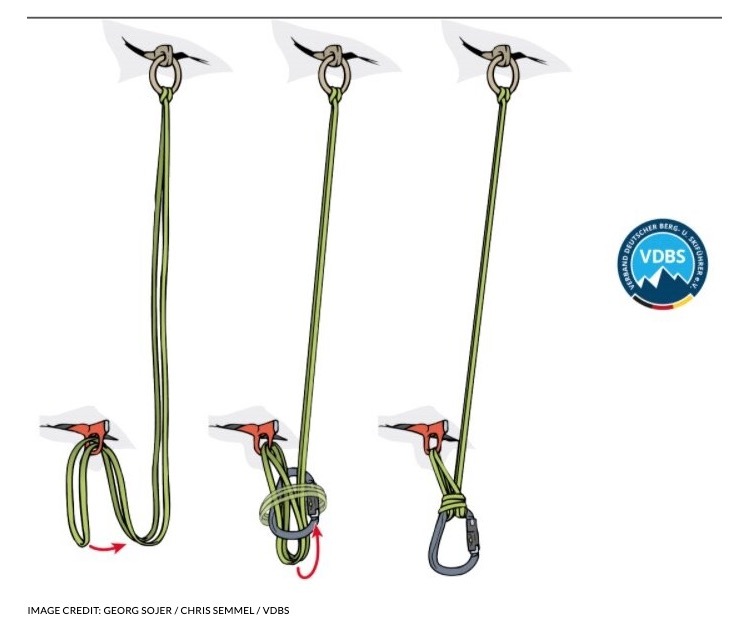Girth hitched master point - redundant?
|
|
I have seen the following anchor setup described in a few sources: two bolts, a single length sling clipped into both, and a locking carabiner girth hitched between them (see picture). |
|
|
Check out Yann Camus' girth x. Shit will change yo life. |
|
|
Thanks, that's exactly what I was looking for. |
|
|
There’s an interesting video on YouTube from Karsten Delap about this. It briefly summarizes some testing from the most recent AMGA conference. The TLDR seems to be that dyneema can slip at lower loads (~5 kN), particularly on round-stock metal such as rings or round-stock carabiners. The testing points to a girth hitched sliding x being a better solution. Karsten also recommended using an I-beam cross-section. |
|
|
|
|
|
It’s been studied (see other posts on this and reference Derek DeBruin’s paper). TL;DR It’s bomber
Focus more on the simplicity of sharing/distributing the load, the non-extension benefits that if a bolt or screw or cam/nut does happen to blow out, any slippage is a smooth energy absorber to reduce load and shock on the remaining piece. I don’t bother with Yann’s hand wringing and x version, simply because the scenario where a leader pulls off rocks, AND does a high FF whip, AND those rocks hit my belay and cut a leg of my anchor (without killing me), AND then it all winds up being enough to pull completely thru…is too far down my list of things to worry about. Probably right below whether the milk in my pre-climb latte was fresh enough. Aside from the very rare set of circumstances where a cut sling could conceivably pull thru, many miss the point of the benefits of the shock/energy absorption of the slippage. If for some reason one of my anchors blows out, I WANT to shave as much load as possible on the remaining piece, and some slippage in the girth hitch is a FEATURE. Edit: to Jared. Since you’re in St. Paul, I’ll offer to do a drop test for you to prove it to you. |
|
|
Hi all, yes like Mitch said check out the youtube girth hitch tests its good info. When I do multi-pitch climbing and going to swing leads I just use the rope to build the anchor using the double figure eight on a bit with the bunny ears so can equal the load if you need longer or shorten the legs. |
|
|
Mark Pilate wrote: Some of those loads with the 8mm dyneema were comically small. If a leg gets cut at a hanging belay you could very truly possibly be fucked. Granted options are to use literally any other material, but the girth X is a good solution also. |
|
|
Mark, if you're offering to whip onto this, I'm there. |
|
|
Bb Cc wrote: By offering increased resistance, yes. Not a guarantee of survival of course, but much better odds. |
|
|
I’ll replace anyone’s girth hitch that cuts and pulls completely through. I’d like someone to walk through and describe this scenario and then say they worry it could happen more than they worry about the rope being cut, their belay loop being cut, their belay biner or belay device breaking, the whole mountain giving way, etc. It’s all happened before for sure. I missed being on Northcutt-Carter by a week before it collapsed. But ya gotta pick your worries. |
|
|
Mark Pilate wrote: You're at a hanging belay and rockfall cuts part of the anchor, then the 1.5kn or whatever is enough to slowly pull through the 8mm dyneema. An admittedly rare but possible scenario that has led to anchor failures and both single and double fatalities. Not using 8mm dyneema is clearly a viable option, but if using 8 or 11mm dyneema why not take one additional small step that will increase safety factor? |
|
|
|
|
|
Ricky Harline wrote: I would for bolts. But for ice screws or trad gear, I’ll take the slippage for better equalization and the shock absorbing features over the cutting/pull thru risk. |
|
|
forgive me if this has been addressed but all of the pull tests that YC referenced in his video had cloves that were nowhere near as tight as I cinch them (on an edelrid slidelock or petzl SM'd, both somewhat I-beam style lockers)... I'd love to see if there's any difference with a well cinched clove, vs the loose clove that I felt was displayed in the video. As Mark points out, the chances of the perfect storm is the sort of concern that leads people to construct 4 piece equalized anchors on 50sq foot ledges with bomber gear... stop overbuilding anchors, less time on rock = higher degree of safety. So many seem to forget this part of the equation. |
|
|
Doing this way on a 20 pitch route might save 1-2 minutes. But sure, why not; it's as good as anything else. |
|
|
Bb Cc wrote: I'm not going to pretend to understand why the girth X has increased friction, but the numbers in the tests are indeed bigger. |
|
|
If the highly improbable rock that cuts a single stand of a girth hitch sling land in a slightly different location, for example the master point or the carabineer, your whole system will fail. If you want to protect against that perhaps a master point only anchor is not adequate. Personally a single sling girth hitched to a master point is adequate for my risk tolerance. |
|
|
The OP asks an excellent question that many people wonder about. I wrote a detailed article about this topic on my website. It references Derek DeBruin's study. The girth hitch master point is advocated by the VDBS, which is the German Mountain and Ski Guides Association (“Verband Deutscher Berg und Skiführer”), some of the most technically competent experts in the world. If it's good enough for them it's good enough for me. Image below from one of their publications. Here's my article if you'd like to take a deeper dive: https://www.alpinesavvy.com/blog/try-a-girth-hitch-at-the-master-point and https://www.alpinesavvy.com/blog/anchor-overview-a-german-perspective |

 Continue with onX Maps
Continue with onX Maps Sign in with Facebook
Sign in with Facebook























